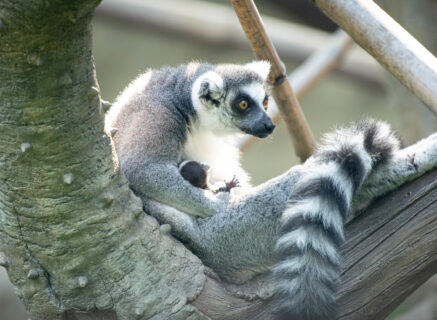Extraordinary Measures: A Ring-tailed Tale
September 22 Update
During an evaluation last week, the Zoo’s medical team found that Cleo wasn’t gaining quite as much weight as they had hoped with the supplemental feedings, and that mom Cairrean had stopped producing milk. The care team decided that the next course of action is to hand-rear Cleo in a location where she and mom can still see each other. This is important so that they can maintain their strong bond while baby Cleo gets all her nutrition given to her by the animal care staff. So far, this is working! Cleo is eating and adapting well!
September 15 Update

As a part of newborn care for all animals at the Houston Zoo, our animal care professionals look for growth markers during regular checkups. Recently, the team noticed that ring-tailed lemur infant, Cleo, was smaller than they expected her to be for her 6-week age and not using her hind-legs to grip mom as tightly as she should.
The primate team and veterinarians huddled to make a plan to help Cleo pack on the pounds. First step, supplemental feedings! The keepers who have dedicated their lives to caring for our primates asked mom Cairrean to bring Cleo over to be bottle fed, and to our delight, she did! For the past few days, Cairrean has successfully brought her baby to the keepers for additional feedings. During the bottle-feedings, the team has noticed that it appears Cairrean isn’t producing enough milk, so they have begun to provide milk-production medication to her diet in hopes that she will be able to effectively nurse again soon.
The team will continue to monitor Cleo’s progress, and we will take you along on this extraordinary effort to provide excellent health care to the animals in our Zoo.
The Houston Zoo is dedicated to saving animals in the wild, including endangered lemurs. Native only to the small island of Madagascar, lemurs are threatened by deforestation, habitat fragmentation, and hunting. To save these animals from continued decline, the Houston Zoo partners with a Malagasy (native people of Madagascar) conservation organization based in Madagascar called GERP, a French acronym that translates to Primate Education and Research Program. GERP is comprised of many Malagasy researchers and conservationists that have grown up around the areas where they now work to protect the wildlife and habitat. Not only do they address threats to the animals, but they also have a clear understanding of the challenges their own local people face as well. In finding solutions that benefit the people and animals, they successfully protect the forest and lemurs in Madagascar.
Guests of the Houston Zoo support this lemur-saving work through their visit and can see ring-tailed lemurs in Wortham World of Primates in the center of the Zoo. People can take action to help save these unique animals at home by simply being aware of the kind of woods they buy. Many precious types of woods such as rosewood and ebony are illegally logged from Madagascar’s forest to be made into furniture, musical instruments, and other items. Avoid rosewood and ebony and buy locally sourced wood products wherever possible.
